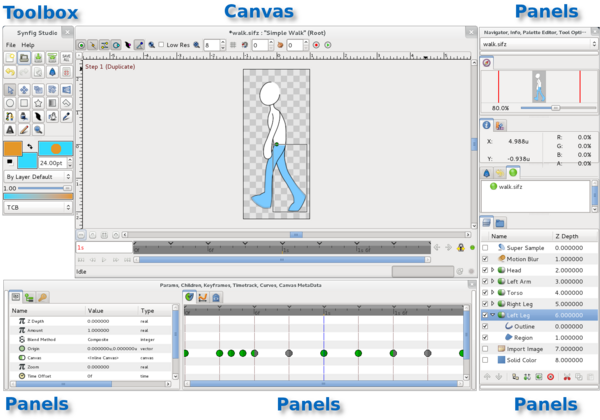Doc:Getting Started/fr
| Language: |
English • čeština • Deutsch • español • suomi • français • italiano • 日本語 • Nederlands • polski • português • română • русский • 中文(中国大陆) • 中文(台灣) |
EN COURS DE TRADUCTION
... PATIENCE.
Introduction
Lorsque vous démarrez Synfig Studio, les fenêtres suivantes apparaissent:
Les composants principaux sont:
- Toolbox — The Toolbox is the main Synfig Studio window. Closing that window means exiting from application. It contains system menu and buttons, tools and some other stuff necessary to create and edit your artwork.
- Canevas — The Canvas is where your artwork and animations will appear.
- Panels — Panels contain tools and information about certain elements of your project. Some panels will even allow you to modify those elements.
|
Note If your Synfig Studio interface layout looks different, fortunately the arrangement shown in the screenshot is pretty easy to recover. In the "File" menu from the Toolbox select "Panels → Reset Windows to Original Layout".
|
Window at the center is called Canvas Window. Each time you starting Synfig Studio, a new Canvas Window is opened. This window represents the Root Canvas, not that that means much to you at the moment, but that's OK — I'm just trying to show you around. In the upper left corner of the Canvas Window, you'll see a button with a caret. If you click on this button, the canvas window menu will pop up. (As an aside, if you right click in the canvas area and there is not a Layer under the mouse position, this menu will also appear.) So now you know where the menu is in the Canvas Window. Good.
The other two windows (one on the bottom, and one to the right) are customizable dock dialogs. Each dock dialog contains a set of panels, arranged horizontally or vertically. Some panels sharing the same space inside of the dock dialog and you can switch between them by clicking on their tabs. You can rearrange the contents of dock dialogs as you wish by simply dragging the panel tab to where you want it. You can even create a new dock dialog by dragging a tab out of the dock dialog it was inside of.
If you ever accidentally close a panel (by dragging it out of the dock dialog, and closing the new dock dialog that gets created), no worries. Simply go to the toolbox, go to "File → Panels" in toolbox menu and then click on the name of the panel you need.
There are a lot of panels in Synfig Studio. If you have no idea what a panel does, simply hold your mouse over its tab icon and a tooltip will pop up describing the name of the panel.
Here are some of the most important ones:
- Panneau Calques — This panel shows you the layer hierarchy for the currently selected canvas. It also allows you to manipulate these layers.
- Params Panel/fr — This panel will show you the parameters of the currently selected layer, (OR, if multiple layers are selected, it shows you only the parameters that the selected layers have in common).
- Tool Options Panel — This panel shows you any options specific to the currently selected tool.
- Navigator — This shows a thumbnail image of what the currently selected canvas looks like. You can also zoom in and move the focus around with this panel.
- Panneau Historique — This shows you the history stack for the current composition. You can also edit the actions in history.

